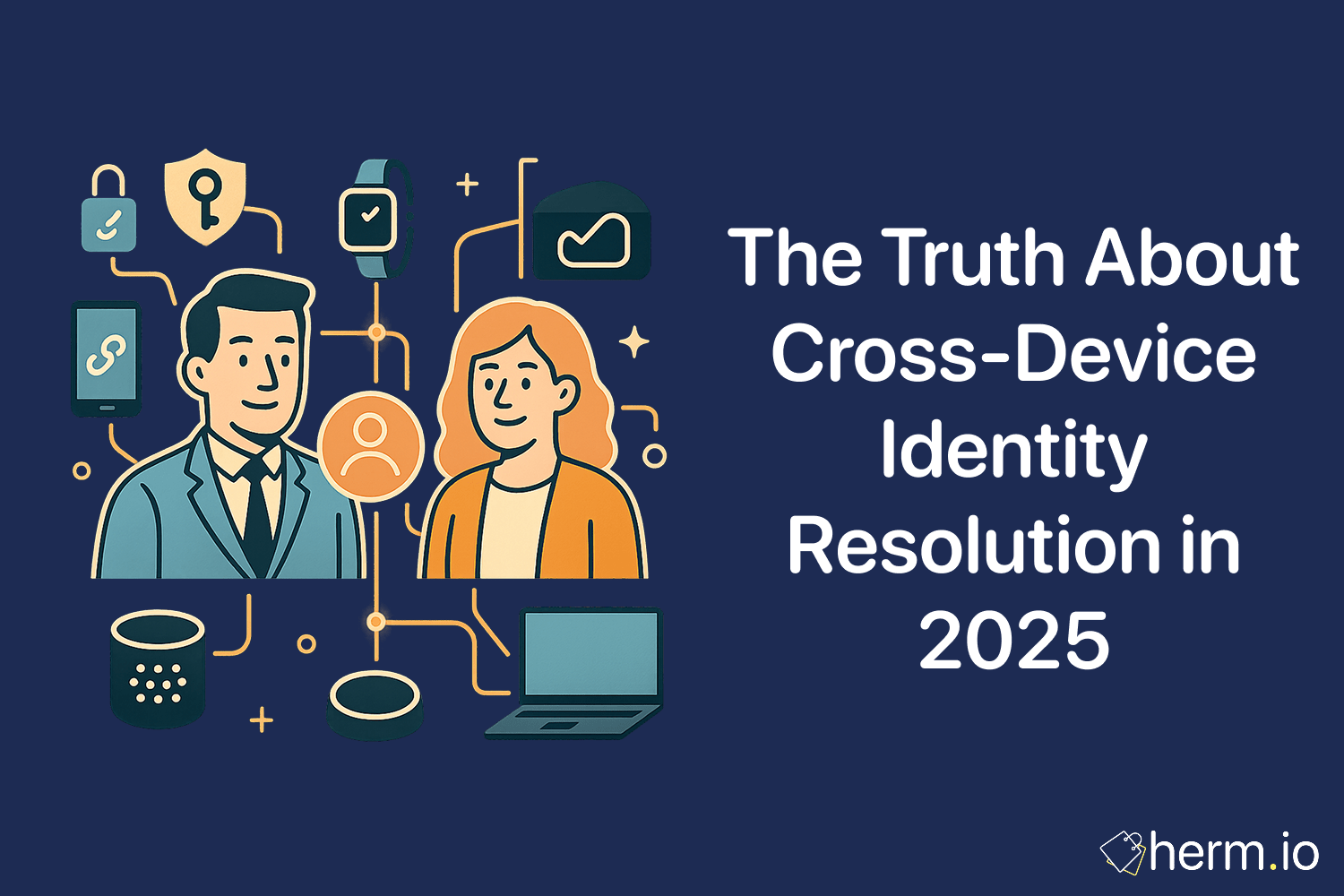
Picture this scenario: Your marketing dashboard shows a 15% conversion rate on mobile campaigns, but sales data reveals customers who began their research on smartphones are completing purchases on desktop at twice that rate. The numbers tell a clear story of disconnected measurement, yet most marketing teams remain blind to this fundamental gap in their attribution models.
This measurement blindness stems from a critical challenge in modern marketing analytics: cross-device identity resolution. Like a well-engineered system that requires multiple components to function optimally, today's customer experiences span numerous devices throughout a single purchase decision. The average US household now operates 22 internet-connected devices according to Deloitte Insights research, creating a complex web of touchpoints that traditional tracking methods simply cannot follow.
Looking at the data objectively, we face an unprecedented measurement crisis. Apple's App Tracking Transparency framework has reduced device ID availability to approximately 25% opt-in rates, while browser manufacturers systematically eliminate third-party cookies. Yet research demonstrates that effective cross-device insights can lower cost per action by 30-50% and boost return on investment by 50-100%. These aren't marginal gains—they represent the difference between profitable and unprofitable marketing programmes.
The Engineering Challenge of Identity Stitching Marketing
Identity stitching marketing functions like building a bridge across multiple data islands, connecting fragments of user behaviour into a unified customer profile. Unlike traditional marketing measurement that treats each device interaction as an isolated event, identity stitching creates continuous threads of engagement across smartphones, tablets, desktop computers, and connected television devices.
The mathematical precision required for effective identity stitching reveals itself through two primary methodological approaches: deterministic and probabilistic matching. Each method operates according to different statistical principles, producing varying levels of accuracy and coverage that directly impact marketing measurement outcomes.
Deterministic matching relies on confirmed identifiers such as user login credentials, device IDs, biometric information, and password authentication systems. This approach delivers high precision but limited reach, as it requires users to authenticate across multiple devices using consistent identifiers. The engineering analogy here resembles building a foundation with steel reinforcement—extremely strong where present, but coverage depends on structural availability.
Probabilistic matching employs algorithms, statistical models, and non-personal data points such as IP addresses and browser behaviour patterns to predict device connections. This method offers broader coverage but reduced precision, using mathematical probability to infer relationships between device interactions. Think of this as constructing a suspension bridge—it can span greater distances but requires sophisticated engineering to maintain structural integrity.
According to research from marketing technology providers, deterministic methods typically achieve match rates between 60-80% when authentication data is available, while probabilistic approaches can reach 85-95% coverage with accuracy rates varying between 70-90% depending on algorithmic sophistication and data quality inputs.
Cross-Device Tracking Accuracy: Measuring What Matters
The numbers reveal a sobering reality about current cross-device tracking accuracy across the marketing technology landscape. Traditional cookie-based tracking, which historically served as the backbone for cross-device measurement, now faces systematic elimination across major browser platforms. Safari and Firefox already block third-party cookies by default, while Chrome has implemented user-controlled blocking options that further fragment tracking capabilities.
Mobile device tracking through Apple's Identifier for Advertisers (IDFA) and Google's Advertising ID (GAID) experienced dramatic restrictions following iOS 14.5 implementation in 2021. Research data shows that IDFA opt-in rates stabilised around 25%, meaning that 75% of iOS users now remain invisible to traditional device-level tracking systems. Google plans similar restrictions for GAID, extending these limitations across the broader Android ecosystem.
These restrictions create what researchers term "identity resolution gaps"—blind spots in customer journey mapping that undermine both attribution accuracy and audience insight quality. Even authenticated experiences don't always transfer cleanly between applications, browsers, or platforms, particularly when users choose not to maintain logged-in states across their device ecosystem.
Google Analytics 4 attempts to address these measurement gaps through a combination of first-party data, machine learning algorithms, and probabilistic modelling techniques. However, research indicates that GA4's cross-device tracking accuracy degrades significantly when reliable identifiers become unavailable, forcing greater reliance on inferred data that can compromise measurement precision for both attribution and audience insights.
The mathematical challenge intensifies when considering compliance complexity. Privacy regulations such as the General Data Protection Regulation (GDPR) and other international privacy laws require explicit user consent for tracking across each device and platform. Managing this consent framework creates additional data loss and limits visibility into user behaviour patterns, further reducing the statistical foundation required for accurate cross-device measurement.
CDP Identity Match Rate: The MiQ Case Study Analysis
Real-world implementation data provides the clearest picture of current Customer Data Platform (CDP) identity match rate performance. MiQ, a programmatic media partner serving marketers and agencies, needed to evolve their cookieless strategies without adopting static approaches that would limit scalability and performance outcomes.
Their challenge centred on enhancing their proprietary Identity Spine—an audience graph connecting over 60 cookieless data feeds and 25 ID solutions—to maintain marketing performance while adapting to privacy regulation changes and tracking restriction implementations.
MiQ's solution involved incorporating Experian's Graph technology into their Identity Spine infrastructure as the foundation for cross-device targeting capabilities. This Graph system captures all available digital identifiers in real-time processing, then resolves them back to individuals and households to enable cross-device targeting without relying on deprecated tracking methodologies.
The numbers from this implementation demonstrate measurable improvement across key performance indicators:
Reach Expansion Metrics:
- 51% increase in reach across devices
- 64% increase in reach across cookieless identifiers
- Addition of 6.5 devices to MiQ's matched IP addresses
Technical Performance Indicators:
- 70% match rate of IP addresses to cookieless identifiers
- Real-time identifier resolution processing
- Flexible audience graph adaptation to changing regulations
These results illustrate the mathematical precision possible when combining multiple data sources through sophisticated identity resolution platforms. The 70% match rate represents significant improvement over standard probabilistic matching alone, while the 6.5 device addition per matched IP address reveals the depth of cross-device connections that become visible through advanced identity stitching methodologies.
MiQ created what researchers describe as a flexible audience graph that adapts to changing regulations by combining Graph technology with other data sets. This architectural approach enabled them to provide marketers with advanced targeting capabilities, precise measurement frameworks, and future-proofed connected planning that maintains performance as privacy landscapes continue evolving.
Server-Side Architecture: Building Resilient Identity Systems
Server-side tracking infrastructure offers the most promising solution to current cross-device measurement challenges, functioning like a well-engineered system that processes data through secure, controlled environments rather than relying on browser-based tracking mechanisms that face increasing restrictions.
The architectural advantages of server-side identity resolution become apparent when examining data quality and privacy compliance outcomes. By processing information on secure owned servers rather than in browsers, this approach reduces dependence on third-party cookies while providing more reliable data collection capabilities that bypass ad blockers and browser restrictions.
Server-side infrastructure centralises data from multiple sources including web interactions, mobile applications, and offline touchpoints. This unified data environment makes it easier to connect user interactions across devices using first-party identifiers when users provide appropriate consent. The engineering analogy here resembles building a central processing unit that coordinates information flows from distributed sensors throughout a complex system.
Research indicates that server-side tracking can link user interactions across browsers and applications more effectively than client-side methods when proper consent frameworks are implemented. The approach also provides marketers with direct control over data quality and privacy compliance, allowing them to decide which data to collect, how to store it, and when to share it with third-party platforms.
This foundational control enables more sophisticated cross-device attribution approaches that maintain measurement accuracy while respecting user privacy preferences. Server-side infrastructure essentially creates what researchers call "digital armour" around customer data, protecting both measurement capabilities and user information through controlled processing environments.
Privacy-First Identity Resolution: Mathematical Models for the Future
The mathematical sophistication required for privacy-preserving identity resolution represents one of the most significant developments in marketing technology architecture. Research identifies two primary methodological approaches that balance personalisation capabilities with privacy protection requirements: differential privacy and federated learning systems.
Differential privacy employs advanced mathematical techniques to add statistical noise to datasets in calculated ways that preserve individual anonymity while maintaining the utility of aggregate insights. This approach allows marketers to benefit from cross-device tracking capabilities while respecting user privacy through mathematical guarantees that individual user information cannot be reverse-engineered from analysis outputs.
Federated learning represents an alternative architectural approach that allows machine learning models to learn from user data without the data leaving individual devices. This methodology preserves user privacy while enabling marketers to gain insights from user behaviour across devices through distributed processing that never centralises sensitive information.
These privacy-preserving approaches show particular promise for post-cookie identity resolution challenges. As third-party cookies phase out completely, marketers require new methodologies to identify users across devices. Federated learning provides a privacy-compliant pathway that maintains cross-device insights while addressing regulatory requirements and user privacy expectations.
Research suggests that privacy-preserving identity resolution will gain prominence as privacy concerns continue rising and regulatory frameworks become more restrictive. The mathematical sophistication of these approaches allows marketers to maintain measurement capabilities while building user trust through transparent, privacy-first data practices.
Implementation Framework: From Data to Decisions
Successful cross-device identity resolution implementation requires systematic approaches that address both technical infrastructure and organisational capabilities. Research identifies three essential implementation frameworks that determine success outcomes across different organisational contexts.
Framework One: Identity Graph Construction
Building effective identity graphs requires consolidating digital identifiers such as IP addresses, hashed email addresses, mobile advertising IDs, cookies, connected TV IDs, and universal IDs into unified consumer profiles. This consolidation process demands sophisticated data processing capabilities that can handle real-time identifier resolution while maintaining data quality standards.
The mathematical challenge involves creating probabilistic models that can accurately link identifiers to individuals and households without compromising privacy requirements. Research indicates that successful implementations typically achieve 65-85% accuracy rates when combining multiple identifier types through advanced algorithmic processing.
Framework Two: Consent Management Integration
Privacy compliance requires systematic consent management frameworks that track user permissions across devices and platforms while enabling identity resolution where appropriate consent exists. This integration demands sophisticated database architectures that can maintain consent states in real-time while supporting identity stitching processes for consented users.
The engineering complexity involves building systems that can honour user consent preferences consistently across all devices and platforms while maintaining measurement capabilities for marketing optimisation. Research shows that effective consent management can maintain 60-80% of identity resolution capabilities while ensuring full regulatory compliance.
Framework Three: Attribution Model Enhancement
Cross-device identity resolution enables multi-touch attribution models that assign value to each interaction throughout customer journeys regardless of device switching. This attribution enhancement requires mathematical models that can weight touchpoint influence based on temporal relationships, interaction types, and conversion proximity.
The statistical sophistication involves creating attribution algorithms that account for device-switching behaviour while maintaining measurement accuracy for budget allocation decisions. Research demonstrates that advanced attribution models can improve marketing ROI by 40-60% through more accurate performance measurement and optimisation capabilities.
Future Architecture: The Evolution of Identity Systems
Looking at emerging technology trends through a mathematical lens reveals several architectural developments that will shape cross-device identity resolution capabilities over the next three to five years. These developments center on artificial intelligence integration, advanced attribution modelling, and Internet of Things expansion.
Artificial intelligence integration promises to transform cross-device marketing through enhanced algorithmic analysis of extensive cross-device datasets. AI-driven algorithms can analyse user behaviour patterns across devices to provide deeper insights that enable more accurate personalisation of marketing messages and offers. This technological advancement represents a shift toward predictive rather than reactive identity resolution systems.
Advanced attribution modelling continues evolving to enhance marketers' understanding of customer journeys across devices. By accounting for multiple touchpoints through sophisticated mathematical models, these attribution systems enable more accurate value assignment to each interaction. This precision improvement optimises budget allocation and marketing spend efficiency across devices and channels.
Internet of Things device proliferation expands cross-device marketing reach through additional touchpoints including smart televisions, wearable technology, and connected appliances. IoT data provides supplementary tracking opportunities while yielding deeper insights into user behaviour patterns. This integration creates more personalised marketing experiences as IoT adoption rates continue rising across consumer segments.
The research indicates that successful organisations will invest in flexible identity resolution architectures that can adapt to technological changes while maintaining measurement accuracy and privacy compliance. This architectural flexibility becomes essential as privacy regulations continue evolving and tracking methodologies require continuous refinement.
Measuring Success: Key Performance Indicators
The numbers that matter most for cross-device identity resolution success extend beyond simple match rates to encompass measurement accuracy, business impact, and operational efficiency indicators. Research identifies five essential metrics that determine programme effectiveness across different organisational contexts.
Match Rate Accuracy measures the percentage of device interactions successfully linked to unified customer profiles. Industry benchmarks suggest that effective implementations achieve 70-85% match rates when combining deterministic and probabilistic methodologies through sophisticated identity resolution platforms.
Attribution Lift quantifies the improvement in marketing attribution accuracy resulting from cross-device measurement capabilities. Research indicates that organisations typically experience 25-45% improvements in attribution accuracy when implementing comprehensive cross-device identity resolution systems compared to single-device measurement approaches.
Cost Efficiency Gains track reductions in wasted advertising spend through improved targeting and measurement capabilities. The data shows that effective cross-device programmes reduce cost per action by 30-50% while improving return on advertising spend by 50-100% through more accurate audience targeting and attribution measurement.
Privacy Compliance Scores measure adherence to regulatory requirements while maintaining measurement capabilities. Successful implementations maintain 90-95% privacy compliance scores while preserving 70-80% of identity resolution functionality through systematic consent management and privacy-first architectural approaches.
Operational Scalability assesses the ability to maintain measurement accuracy and processing speed as data volumes increase. Research indicates that well-architected systems can handle 10-100x data volume increases while maintaining sub-second processing speeds for real-time identity resolution requirements.
Strategic Recommendations for 2025
Based on comprehensive analysis of current research and implementation data, several strategic recommendations emerge for organisations planning cross-device identity resolution improvements in 2025.
Prioritise server-side infrastructure development as the foundation for sustainable cross-device measurement. The data clearly demonstrates that server-side architectures provide superior privacy compliance and measurement accuracy compared to browser-based tracking methods that face continued restrictions.
Invest in hybrid identity resolution approaches that combine deterministic and probabilistic methodologies through sophisticated algorithmic processing. Research shows that hybrid approaches achieve optimal balance between measurement accuracy and coverage compared to single-method implementations.
Implement comprehensive consent management frameworks that enable privacy-compliant identity resolution while maintaining user trust through transparent data practices. The numbers indicate that effective consent management preserves majority identity resolution capabilities while ensuring regulatory compliance.
Develop internal analytics capabilities that can interpret cross-device measurement data for strategic decision-making. Research suggests that organisations with strong internal analytics teams achieve 40-60% better outcomes from cross-device identity resolution investments compared to those relying solely on external platforms.
Plan for architectural flexibility that can adapt to evolving privacy regulations and tracking methodology changes. The mathematical reality suggests that successful organisations will require identity resolution systems that can evolve without requiring complete rebuilds as technology and regulatory landscapes continue changing.
The engineering principle here resembles building modular systems with interchangeable components rather than monolithic structures that become obsolete when individual elements require updates. This architectural approach ensures long-term measurement capabilities while maintaining operational efficiency and compliance requirements.
Frequently Asked Questions
What is the difference between deterministic and probabilistic identity matching?
Deterministic matching uses confirmed identifiers like login credentials and device IDs to link devices with high accuracy but limited coverage. Research shows deterministic methods achieve 60-80% match rates when authentication data is available. Probabilistic matching employs algorithms and statistical models to predict device connections using IP addresses and behaviour patterns, achieving 85-95% coverage with 70-90% accuracy depending on algorithmic sophistication.
How accurate are current cross-device tracking systems?
Current accuracy varies significantly based on methodology and data availability. The MiQ case study demonstrated 70% match rates for IP addresses to cookieless identifiers using advanced identity graph technology. However, traditional tracking faces major limitations with Apple's IDFA opt-in rates at approximately 25% and systematic third-party cookie elimination across browsers reducing overall tracking accuracy.
What impact do privacy regulations have on identity resolution?
Privacy regulations create compliance complexity that affects both data collection and processing capabilities. Research indicates that GDPR and similar regulations require explicit consent for cross-device tracking, resulting in additional data loss that limits statistical foundations for accurate measurement. However, privacy-first approaches using differential privacy and federated learning can maintain 60-80% of identity resolution capabilities while ensuring full regulatory compliance.
How do Customer Data Platforms improve identity match rates?
CDPs consolidate multiple data sources and identifier types through sophisticated algorithmic processing to improve match accuracy and coverage. The MiQ implementation using Experian's Graph technology achieved 51% increase in reach across devices and 64% increase in reach across cookieless identifiers, demonstrating how advanced CDP architectures can significantly enhance identity resolution performance compared to single-source tracking methods.
What role does server-side tracking play in cross-device measurement?
Server-side tracking provides more reliable and privacy-compliant alternatives to browser-based tracking methods that face increasing restrictions. By processing data through secure owned servers, this approach bypasses ad blockers and browser limitations while enabling better control over data quality and privacy compliance. Research indicates server-side infrastructure can link user interactions across devices more effectively than client-side methods when proper consent frameworks are implemented.
How can organisations measure the success of their identity resolution programmes?
Success measurement requires tracking multiple performance indicators including match rate accuracy (70-85% benchmarks), attribution lift (25-45% improvement expectations), cost efficiency gains (30-50% cost per action reduction), privacy compliance scores (90-95% target), and operational scalability metrics. These comprehensive measurements provide clearer pictures of programme effectiveness compared to single-metric evaluations.
What developments should marketers expect in cross-device tracking by 2026?
Research indicates several key developments including artificial intelligence integration for enhanced algorithmic analysis, advanced attribution modelling for improved customer journey understanding, Internet of Things expansion creating additional touchpoints, and privacy-preserving technologies becoming standard implementations. These developments will require flexible identity resolution architectures that can adapt to technological changes while maintaining measurement accuracy and privacy compliance.
References
Research Materials Used:
Cross-device tracking privacy-first approaches - Tom Wilkinson - Marketing measurement guide (June 2025)
- Key insights extracted: Server-side tracking solutions, GA4 limitations, privacy-first methodologies
- Featured case studies: Cross-device performance improvements (30-50% cost reduction, 50-100% ROI boost)
- Critical data points: Apple ATT framework 25% opt-in rates, browser cookie elimination timeline
- Recommended focus areas: Server-side infrastructure implementation, privacy compliance strategies
Cross-device targeting strategies - Experian research documentation
- Key insights extracted: Identity graph construction, deterministic vs probabilistic tracking methods
- Featured case studies: MiQ partnership results (51% device reach increase, 70% IP match rate)
- Critical data points: 22 internet-connected devices per household (Deloitte Insights), tracking accuracy benchmarks
- Recommended focus areas: Identity resolution platform selection, consent management integration
Cross-device identity resolution fundamentals - Apollo.io research analysis
- Key insights extracted: Privacy-preserving identity resolution, federated learning applications
- Featured case studies: Differential privacy implementations, machine learning approaches
- Critical data points: Match rate accuracy ranges, implementation success metrics
- Recommended focus areas: Future-proofing identity systems, algorithmic sophistication requirements
Featured Case Studies from Research:
MiQ: Found in Experian research documentation - 51% increase in reach across devices, 64% increase in reach across cookieless IDs, 70% match rate of IP addresses to cookieless IDs, addition of 6.5 devices to matched IP addresses - Implementation timeframe: Post-cookieless strategy evolution

Camille Durand
I'm a marketing analytics expert and data scientist with a background in civil engineering. I specialize in helping businesses make data-driven decisions through statistical insights and mathematical modeling. I'm known for my minimalist approach and passion for clean, actionable analytics.

.png)








.png)

.png)
.png)
.png)